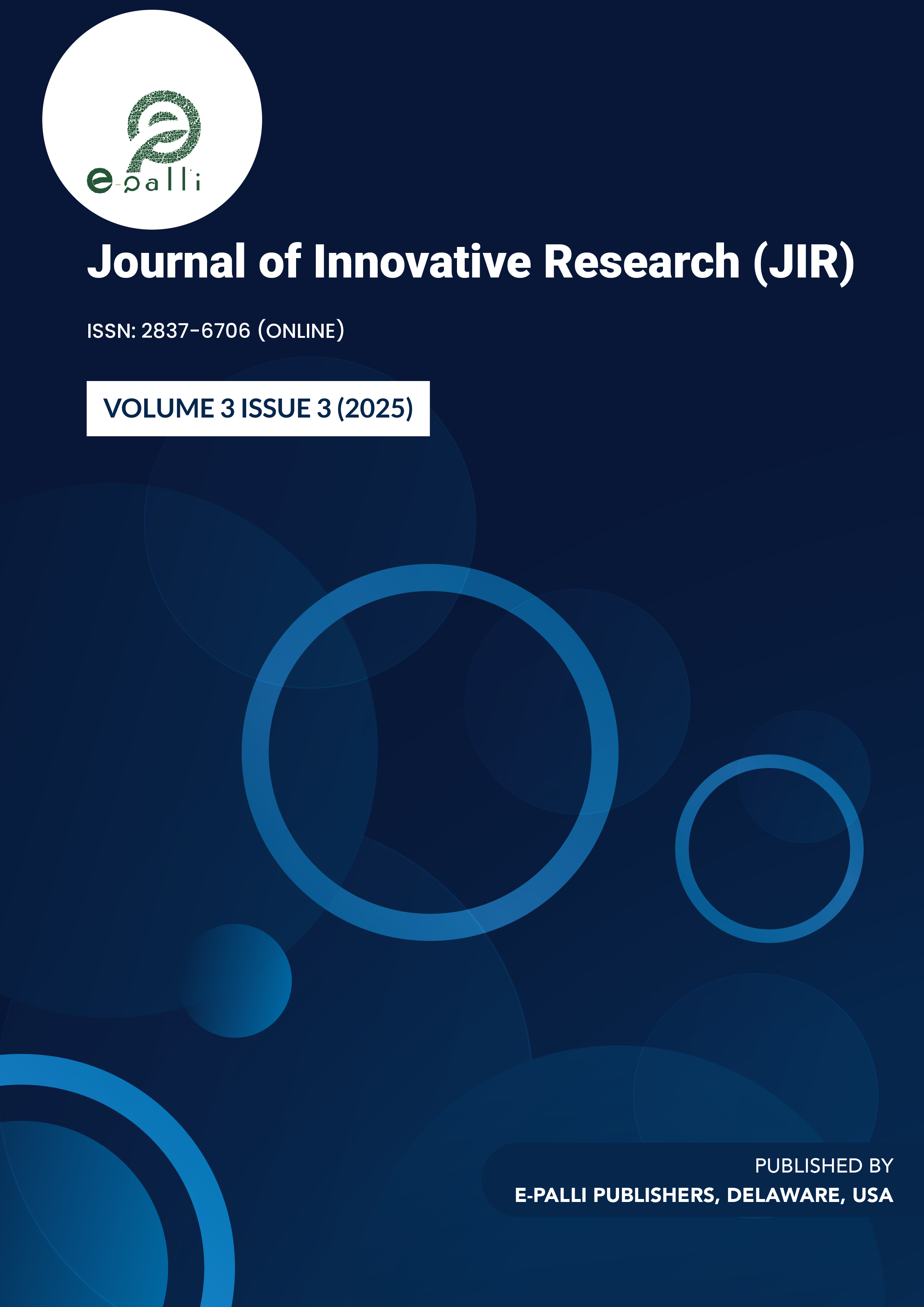Spatio-Temporal Assessment of Deforestation Scenarios and Their Management Strategies Using Geographic Information System in Seven Sister States of Northeast India
DOI:
https://doi.org/10.54536/jir.v3i3.5664Keywords:
Deforestation, Factors, GIS, Management, N-E India, UrbanizationAbstract
The seven sister states in the northeastern region of India are responsible for a large portion of the country’s forest degradation. One-fourth of India’s total forest cover is found in the Northeast. It is equally significant as the Amazon rainforest, which has a big impact on the global climate. Tribes predominate in the northeast, where shifting farming is common. Due to population pressure, this approach is no longer viable for this location, as the jhum cycle is decreasing and there is no possibility of forest land recovery. In the past, it was viable for the high jhum cycle. Apart from population pressure from shifting farming, urbanization, development, smuggling, fuelwood extraction, forest fires, and forest-based industries, forest degradation is also driven by illegal logging, overgrazing, mining, encroachment, and climate change impacts. They are to blame for the area’s deforestation. Additionally, this region is impacted by soil erosion, flash floods, siltation load, climate change, higher-than-normal temperatures, a lack of regular rainfall, and biodiversity loss because of extensive deforestation. We must reach our goal of 33% forest area soon if all policies are applied correctly and people are mindful of their livelihood. This study discusses the current deforestation trend, the several causes of deforestation, and the effects of deforestation on the Northeastern seven sister states.
References
Bhagawati, A. (2018). Human encroachment and forest change. Journal of Environmental Studies, 12(3), 145–153.
Chabukdhara, M., & Singh, S. K. (2016). Surface water quality monitoring, assessment and prediction using machine learning techniques. Environmental Science and Pollution Research, 23(13), 13222–13231.
Das, A. (2004). Climate change and variability in the northeast Himalayas. Indian Geographical Journal, 79(2), 89–95.
Das, A., & Ghosh, S. (2009). Assessment of flood and drought vulnerability in the Brahmaputra basin. Indian Meteorological Society Bulletin, 41(1), 15–28.
Deka, J., & Sarma, K. (2010). Ecological implications of shifting cultivation in northeast India. Tropical Ecology, 51(2S), 289–299.
Devi, R., & Bimolata, T. (2012). Population pressure and forest degradation: A case study in Manipur. Asian Journal of Environment and Disaster Management, 4(4), 489–497.
Dikshit, K. R. (2014). Northeast India: Land, people and economy. New Delhi: Rawat Publications.
Dutta, B. (2006). Impact of floods on environment and livelihood in Assam. Geography Review of India, 68(4), 52–60.
Dutta, P. (2016). Environmental consequences of coal mining in Meghalaya. Energy and Environment Journal, 27(3), 239–249.
Dutta, P., & Das, A. (2014). A spatio-temporal analysis of forest cover change in northeast India. Journal of Indian Society of Remote Sensing, 42(1), 157–168.
Forest Survey of India. (2011). India State of Forest Report 2011. Dehradun: Ministry of Environment and Forests, Government of India. Retrieved from https://fsi.nic.in
ICIMOD. (2008). Impact of climate change on Himalayan ecosystems. Kathmandu: International Centre for Integrated Mountain Development.
IPCC. (2007). Climate change 2007: Impacts, adaptation and vulnerability. Contribution of Working Group II to the Fourth Assessment Report of the IPCC. Cambridge University Press.
IPCC. (2009). Climate change and water. Technical Paper VI. Intergovernmental Panel on Climate Change.
Iqbal, M. (2018). Urban expansion and forest cover loss in the lesser Himalayas. Sustainable Cities and Society, 40, 533–543.
Khaniar, R. (2014). Migration and land use changes in northeast India. Journal of Regional Studies, 22(1), 77–86.
Kumari, P. (2019). Shifting cultivation and its role in forest degradation. Journal of Agroforestry and Environment, 13(2), 97–104.
Maikhuri, R. K. (1991). Energy from biomass: Use pattern and forest degradation in northeast India. Biomass and Bioenergy, 1(3), 131–138.
Ministry of Environment, Forest and Climate Change. (2023). Annual Report 2022–23. Government of India. Retrieved from https://moef.gov.in
Mirza, M. M. Q. (1998). Climate change and extreme weather events: Floods and droughts in Bangladesh. Climatic Change, 39(2–3), 287–301.
Mow, J. (2010). The ecology of fire in bamboo forests of Mizoram. Ecotropica, 16(1), 29–38.
NASA Earth Observatory. (2014). Forest fires in northeast India. Retrieved from https://earthobservatory.nasa.gov
Office of the Registrar General & Census Commissioner, India. (2011). Census of India 2011: Primary Census Abstract Data. Ministry of Home Affairs, Government of India. Retrieved from https://censusindia.gov.in
Panda, R. (2017). Tribal agriculture and environmental change in Mizoram. Indian Journal of Ecology, 44(2), 231–238.
Poffenberger, M., & Tiwari, B. (2006). Community forest management in northeast India. New Delhi: Oxford University Press.
Priya, D. (2020). Glacial retreat and flood threats in northeast India. Journal of Environmental Management, 258, 110018.
Ramakrishnan, P. S. (1988). Shifting agriculture and sustainable development in northeast India. Man and Environment, 12(2), 55–65.
Ravindranath, N. H. (2011). Climate policy and forest management in India. Current Science, 101(3), 314–322.
Ravindranath, N. H., & Rao, K. S. (2011). Climate resilience in northeast India. Mountain Research and Development, 31(2), 112–118.
Saikia, P., & Hazarika, M. (2020). Monsoon dependency and rainfall variability in northeast India. Meteorological Applications, 27(1), e1871.
Sangomla, A. (2021). Eurasian snowfall and Indian monsoon linkages. Down to Earth. Retrieved from https://www.downtoearth.org.in
Sarma, K. (2017). Understanding fire incidences in northeast India. Asian Journal of Forest Science, 26(3), 198–206.
Sarmah, R., & Deka, J. (2010). Biodiversity consequences of Jhum cultivation. Indian Journal of Forestry, 33(2), 157–164.
Sharma, N., & Bezbaruah, D. (2007). Economic growth and deforestation in northeast India. Indian Journal of Economics, 87(345), 132–148.
Shree, M. (2019). Extreme heat and climate change in Mizoram. Environmental Climate Review, 17(1), 45–53.
Singh, S. P. (1998). Himalayan glacier dynamics and climate change. Environmental Geology, 34(2–3), 123–132.
Downloads
Published
How to Cite
Issue
Section
License
Copyright (c) 2025 Biswajit Rajak, Champa Ghosh, Ayan Rudra, Tanmoy Basu, Biraj Kanti Mondal

This work is licensed under a Creative Commons Attribution 4.0 International License.






